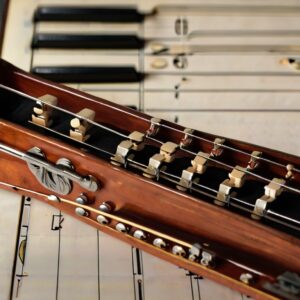Diving straight into the heart of any orchestra, you’ll find a diverse array of instruments. Each of them is important in creating the harmonious and dynamic soundscapes we adore. Exploring these instruments enlightens us about their individual stories and characteristics and deepens our appreciation for the majestic symphonies they produce together.
The String Section
An ensemble that is frequently the most substantial in terms of size and is widely regarded as the orchestra’s backbone. This essential family of instruments includes violins, violas, cellos, and double basses, each playing a pivotal role in contributing to the complex tapestry of orchestral sound. The violins, often divided into first and second sections, deliver soaring melodies and intricate harmonies, while the violas, slightly larger and with a deeper tone, add richness and depth to the musical texture. Cellos bring in a lush, warm sound that enhances the harmonic framework, and the double basses, with their profound resonance, provide the fundamental bass lines that underpin the entire orchestral structure. Together, these instruments produce rich, warm tones that form the foundation of orchestral music, weaving intricate layers of sound that are capable of expressing a wide range of emotions and nuances. This section supports the harmonic and rhythmic framework of the music and is important in defining the character and mood of the piece, making it an indispensable part of the orchestral ensemble.
Violins

Violins stand at the forefront of the string section, distinguished by their prevalence and their division into two distinct groups: the first and second violins. This division is more than just a structural organization; it represents a critical method in the orchestration that allows for a rich interplay of musical ideas. The first violins, typically positioned on the conductor’s left, are usually tasked with carrying the melody. This role places them at the heart of the orchestral narrative, where they can weave intricate musical themes and lead the emotional journey of the piece. The second violins, often positioned to the right of the first violins, serve a complementary role, enhancing the texture with harmonies or crafting counter-melodies that enrich the overall soundscape. Their work is important in adding depth and complexity to the music, allowing for a more nuanced expression. The bright, high-pitched sound of violins is unparalleled in its versatility, capable of capturing a wide spectrum of emotions. From the exhilarating joy and uplifting spirits to the depths of melancholy and haunting sorrow, violins can articulate these emotions with remarkable clarity and intensity. This emotional agility makes them indispensable in creating the dynamic and expressive quality that characterizes much of orchestral music, enabling composers and conductors to tell compelling musical stories that resonate deeply with audiences.
Violas
Violas, with their physical stature modestly outstripping that of violins, present an intriguing tonal breadth that sets them apart within the string family. Their deeper, richer sound emerges from this slightly larger size, allowing them to command the middle range of the orchestral texture with authority. Nestled between the bright, piercing tones of violins and the sonorous depths of cellos, violas serve as the linchpin of the string section, adeptly filling in harmonies and enhancing the ensemble’s sound with their resonant warmth. Though they frequently assume a supporting role, the contribution of violas to the cohesive sound of an orchestra cannot be overstated; their rich timbre and versatile range enable them to bridge the musical gap between the higher and lower registers with unparalleled fluidity.
The role of the viola is multifaceted, often weaving through the musical texture to thicken and color the aural landscape of the orchestra. By providing inner voices, violas add complexity and dimension to the music, ensuring that the harmonic structure is robust and fully realized. This middle voice, so essential to the balance and depth of the orchestral sound, is where the viola shines, seamlessly transitioning from supportive harmonies to more prominent lines that highlight their unique character. The intrinsic value of the viola lies in its ability to meld with other sections while still maintaining its distinct voice, enriching the overall sound without overshadowing. In doing so, violas embody the essence of musical collaboration, playing an instrumental role in crafting the rich, immersive soundscapes that define the very best of orchestral music.
The Woodwind Section
Moving from the lush, harmonious resonance of the string section to the woodwind section is akin to entering a realm of vibrant sonic hues and intricate textures. The woodwind family, consisting of flutes, oboes, clarinets, and bassoons, brings a kaleidoscope of tonal colors that enrich the orchestral palette in profound ways. Each of these instruments carries its distinct personality and expressive potential, collectively weaving a tapestry of sound that can transport listeners from the stirring depths of emotional valleys to the exhilarating peaks of joyous rapture.
The flute, with its silver-toned clarity and agility, soars above the orchestra, often embodying the purity and ethereal qualities of the musical narrative. Its capacity for rapid articulations and lyrical melodies makes it a versatile voice within the ensemble. The oboe, with its reedy, penetrating timbre, adds a layer of poignant expressiveness, capable of evoking a sense of longing or serene contemplation. Its distinctive sound often leads the woodwind choir, offering a counterpoint to the strings’ lushness with its textural richness.
Clarinetists, wielding their instruments’ wide dynamic range and warmth, contribute both the velvety depths of the low register and the bright, focused tones of the upper reaches. This duality allows the clarinet to blend seamlessly across the orchestral spectrum, enhancing both harmony and melody. The bassoon, with its sonorous, earthy voice, anchors the woodwind section, offering depth and gravitas. Its ability to move from comedic interjections to solemn declarations underscores the bassoon’s unique role in adding depth and contrast to the ensemble.
These woodwind instruments create a sonic landscape that is as diverse as it is dynamic. Their contributions, display individual brilliance or in unified passages that showcase their collective artistry, are essential to the orchestral tapestry. The woodwind section, with its array of timbres and expressive capabilities, is important in bringing the conductor’s vision to life, masterfully exploring the full spectrum of musical expression and adding an irreplaceable dimension to the world of orchestral music.
Flutes
The flute, with its bright and clear tonality, possesses the unique ability to rise gracefully above the collective sound of the orchestra, much like a beam of light piercing through a prism to scatter lustrous hues. This instrument, celebrated as one of the oldest woodwind instruments, carries a history as rich and captivating as the melodies it produces. Archetypal in nature, the flute’s lineage stretches back to the dawn of human civilization, where it was fashioned from bones, wood, and other natural materials, serving not just as a musical instrument but as a tool for ritual and communication. Its evolution over centuries has refined its sound and design, culminating in the modern flute, which retains the ethereal and shining tones of its ancestors while benefiting from the precision and versatility afforded by contemporary craftsmanship.
Within the orchestral ensemble, the flute assumes a compelling role. Its ability to cut through the complex tapestry of the orchestra’s sound allows it to deliver ethereal melodies that can elevate a piece from the mundane to the sublime. The purity of the flute’s tone, free from the huskiness that characterizes many other woodwinds, enables it to articulate musical ideas with a clarity that is both refreshing and captivating.
